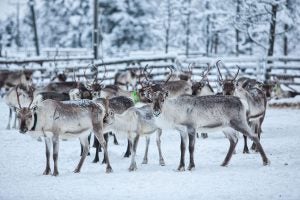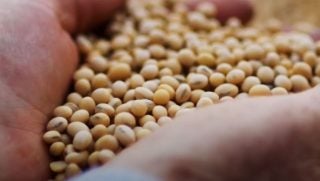If you have some experience in agriculture, odds are you know how deeply ingrained agriculture is in our holiday traditions. Pretty much everyone knows that food comes from agriculture, but let’s explore just how important ag is in the holiday season!
There’s something so peaceful and beautiful about farms and ranches, especially in winter. That must be the reason that they’re often the backdrop for beautiful Christmas cards, winter paintings and Hallmark movies. Next time you’re writing or receiving a card or watching a Christmas movie, take note of just how often farms and ranches are the setting.

Perhaps most notably this time of year, agriculture grows Christmas trees. Somewhere between 25 and 30 million trees are grown each year for Christmas (don’t worry, there are many more planted). With the rise of artificial trees bringing convenience to people, it can be hard to remember that this tradition is deeply rooted in agriculture.
Real (evergreen) Christmas trees actually benefit the environment and are renewable, recyclable, and are often grown in areas that can’t support growing other crops. One of the most iconic Christmas trees bringing attention to agriculture is the Rockefeller Christmas Tree in New York City. This year’s tree is an 80 foot Norway spruce that was grown in New York. This icon of Christmas brings attention to agriculture in a fun way.
We also can’t forget Santa’s reindeer. As most of us know, Santa’s nine reindeer pull his sleigh all around the world on Christmas Eve. Santa’s reindeer were first mentioned in print in 1821. Raising reindeer is also a part of agriculture. Reindeer are the same as caribou and are often referred to as reindeer when domesticated and caribou when wild (there are also some differences in what they’re called geographically). If you find yourself lucky enough to visit a reindeer farm, be sure to notice that reindeer have hair on their noses, which keeps them warm through the cold winters. Reindeer farming isn’t very widespread, but it remains an important part of agriculture and Christmas traditions.

The biggest of all holiday traditions is the food. Of course agriculture supplies the delicious food we rely on. From the Thanksgiving turkey, to the Christmas ham, to each and every side dish, dessert and beverage, it takes thousands of farmers and ranchers to bring a wide variety of food to your table. Long ago (we’re talking pioneer days), there wasn’t nearly the variety of food on the table that there is today.
Access to fresh fruits and vegetables was limited, and meat could often be costly unless you raised or hunted for it yourself. People in cities and areas with larger populations tended to have access to a wider variety of items than people living in more remote areas. As time went on, food access wasn’t as big of a concern, and it wasn’t as strange to start seeing oranges on the dinner table as it once was.
Today, we have wider access to food than ever before. That’s one thing you can count on — our food system gives us options. Meat remains one of the more expensive parts of a holiday meal today, but prices fluctuate depending on supply and demand and any events impacting the industry. Overall, your holiday meal remains pretty affordable at just $6.20 per person. For a 10 person meal with turkey, pumpkin pie, milk, a veggie tray, dinner rolls, peas, cranberries, sweet potatoes and stuffing, the cost is just $61.17. If you add ham, potatoes and green beans, the cost is $84.75. Of course, the most important part of the meal isn’t the cost, it’s the people with you, but it’s still nice to know that you can have a nice holiday meal for under $10 per person.

The drinks are equally important to the holiday season. Winter favorites are family friendly hot chocolate, apple cider, or eggnog, then there’s the alcoholic versions of all of these and more. Agriculture is also responsible for all of these delicious beverages.
Gifts are another holiday staple. No Christmas is complete without a few stocking stuffers and gifts. Without lumber that comes from ag, there would be no wrapping paper. One common gift is clothing. Cotton and wool make up many of today’s garments. Wool is a moisture-wicking, durable, and antimicrobial fabric that makes for great socks, sweaters, gloves, and more! Cotton is comfortable, versatile, and looks good. Whether you’re gifting clothes or wearing your favorite ugly sweater, you are supporting farmers.
As you decorate your Christmas tree, share the magic of Santa, eat amazing food, drink delicious beverages, write cards, and enjoy time with family this holiday season, be sure to think about how none of this would be possible without agriculture. Thank a farmer this holiday season, and every season!
Michelle Miller, the “Farm Babe,” is an internationally recognized keynote speaker, writer, and social media influencer and travels full time to advocate for agriculture. She comes from an Iowa-based row crop and livestock farming background and now resides on a timber farm in North Central Florida.


